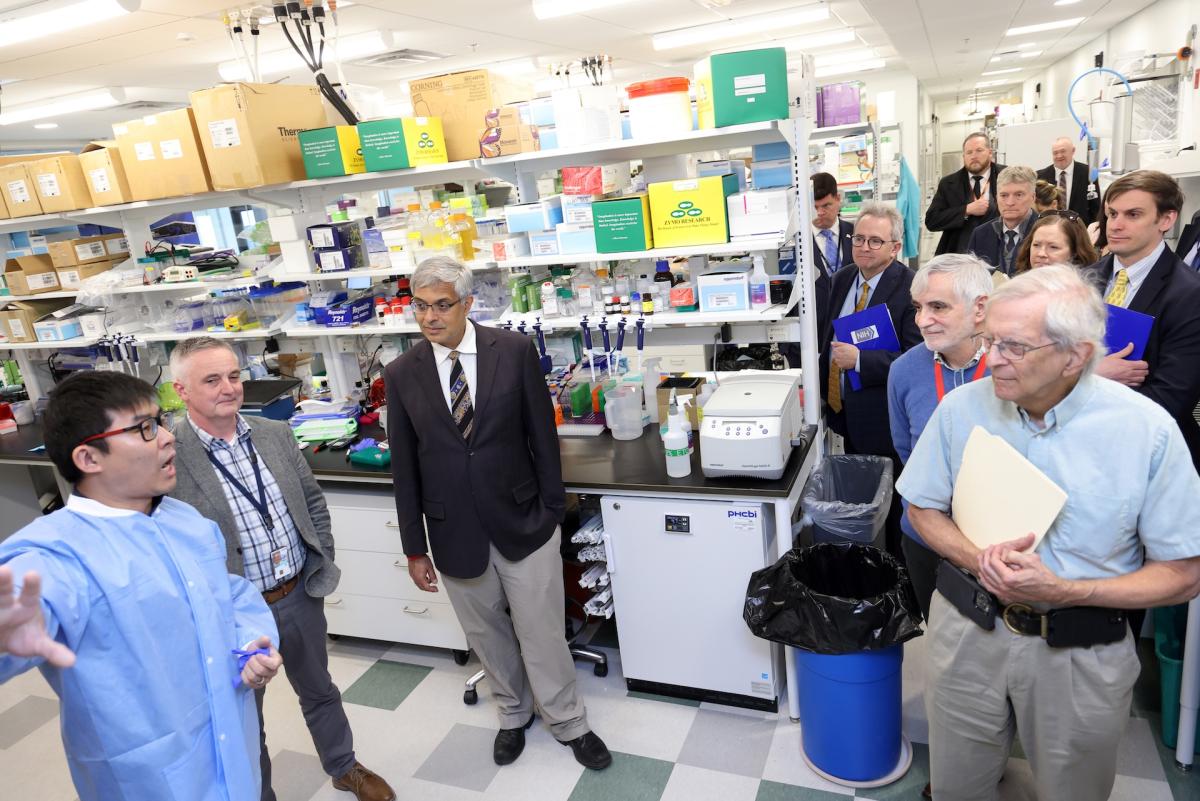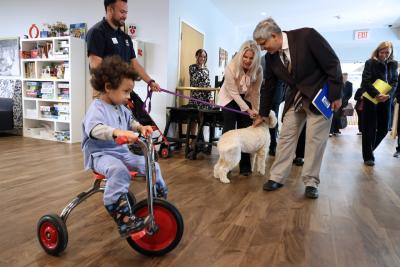18th NIH Director: Jayanta Bhattacharya
New Director Shares Priorities for Replication Studies, Autism Research, and Five Aims for the Future of Biomedical Research
BY THE NIH CATALYST STAFF

CREDIT: CHIA-CHI CHARLIE CHANG
NIH’s new leadership team toured several labs and the Clinical Center in April to learn about the life-saving treatments developed and delivered every day at NIH. Jayanta Bhattacharya (center) became the 18th NIH director on April 1 after 38 years at Stanford University.
Jayanta Bhattacharya began his tenure as the 18th NIH director on April 1. Bhattacharya, a Stanford University (Stanford, California) graduate, professor of health policy, and director of the NIH-funded Center on the Demography and Economics of Health and Aging, presented his priorities for the future of biomedical research to the NIH Council of Councils on April 21.
“I want to talk about my love for the NIH, for the mission of the NIH, and my absolute commitment to the NIH to make sure that the NIH continues to be the crown jewel of biomedical research in the whole world,” Bhattacharya said at the event.
ASD and a real-world data platform
Bhattacharya said he, at the request of the president and HHS Secretary Robert F. Kennedy Jr., will create a research program to gain a better understanding of the etiology of the autism spectrum disorders (ASD).
Bhattacharya said NIH will launch a real-world data platform. The NIH and CMS have since publicly announced a partnership to use electronic health records (EHRs) and claims data from Medicare and Medicaid recipients. HHS also plans to use Veterans Administration EHRs, private sector EHRs, and government and private industry genetics data, pharmacy records, and environmental exposures data.

CREDIT: CHIA-CHI CHARLIE CHANG
“The idea would be that somewhere between 10 to 20 groups of researchers from across the country would be able to ask questions using methods ranging from basic science to epidemiological approaches to other more applied approaches to ask what causes autism and how best we can treat and manage autism so that so many millions of families have an easier time dealing with the problems caused by having an autistic child,” he said.
5 Major Aims: Building Blocks to Improving Health
Bhattacharya presented his blueprint for the future of biomedical research. Following is a short review of the five major aims discussed at the meeting.
- Improve population health: Chronic diseases such as obesity, diabetes, and heart disease will be addressed through the Make America Healthy Again (MAHA) initiative. “We have to find better ways to prevent, treat, and cure chronic diseases,” he said.
- Ensure reliable results: The NIH will restore replication and reproducibility of research by rewarding scientists who participate in replication efforts at the R01 funding level, by launching a replication studies journal, and by instilling replication as a core activity of the NIH.
- Make big advances: “We have seen the graying of the scientific workforce with the age of the first large grant moving from mid-30s to the mid-40s.” He said it is time to ask big questions to realize the possibility of giant advances and cures for diseases, and he noted that it is “time to swing for the fences with bold ideas.”
- Maintain safety and transparency: Noting the COVID-19 pandemic and gain of function research, Bhattacharya said, “I am going to make sure that with congressional efforts and efforts by the administration to regulate the research that we do, that we meet the highest ethical standards and do not endanger human populations in the conduct of research itself.” NIH and HHS have since launched the Generation Gold Standard universal vaccine platform.
- Encourage academic freedom: NIH must foster a culture in which scientists can express disagreement respectfully, he noted, adding that “scientific progress depends on the right for researchers to dissent against scientific dogmas and the NIH will work to make sure that intramural researchers have this kind of academic freedom and that we encourage the same kind of academic freedom with the external scientific community.”
New approach methods for preclinical safety testing, changes in grant funding, and the restructuring of the NIH and HHS were among the topics discussed during the Q&A session that followed his presentation.
“The NIH absolutely must address the key health needs of the country,” Bhattacharya concluded. “Every inch of the federal government is under scrutiny and of course the NIH is not exempt. The mission of the NIH will continue as we navigate these challenges. At the end of all of this, the NIH will be a stronger institution that fosters scientific discussion and debate and advances new technologies and new ways of thinking that will meet the mission better than we currently are.”
The NIH Director will host his first Town Hall on Monday, May 19, at 1 p.m. in Masur Auditorium located in Building 10 and on VideoCast.
Shuttles will be available for the following off-campus locations:
- Rockledge II
- NSC Building
- Fishers Lane
- White Flint Tower II
This page was last updated on Wednesday, June 4, 2025
